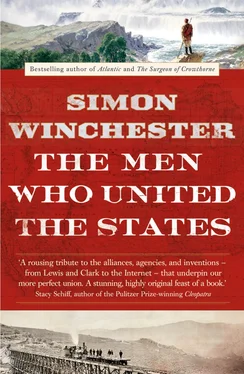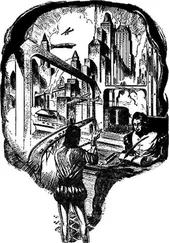In places, the Oregon Trail was fully ten miles wide, with wagons veering wildly away from one another as the steersmen took different tacks to divert around the obstacles ahead. In others, it narrowed sharply, the ruts all commingling, incised ever more deeply into the earth. The Bureau of Land Management, which looks after the public lands of the American West, has seen to it that in many places these gatherings of ruts are preserved: they are easily visible at the great historic site of South Pass, in western Wyoming, for instance.
They can be seen just a few yards off State Route 28, which crosses the Continental Divide here. You step away from the pavement and onto the sagebrush, and there is the track, with its two parallel lines of hard-packed yellow dirt, a wagon-width apart, fading into the horizon. It is 7,500 feet up here, and you might take a few moments to catch your breath. But then if you stand here for a few moments, looking west as a chill breeze from ahead whistles through the short grass, making your eyes water, and the new snow on the peaks of the Wind River Range to the north glints in the evening sun, two things are worth pondering.
The first is the simple political importance of the place. Jedediah Smith, the great trailblazer of the Victorian West, was fully aware of its value. He reported that this was the one certain way through which wagons could cross the Rockies, the one certain road along which people in limitless numbers might one day cross the Great Divide. By urging settlers to cross here, creaking their wagons up from the valley head of the Sweetwater River (a stream whose waters were bound eventually for the Gulf of Mexico and the Atlantic by way of the Platte, the Missouri, and the Mississippi) and then down the far side to the headwaters of the Green River (which joins the Colorado and passes through the Grand Canyon to the Gulf of California and the Pacific Ocean), he left an indelible imprint on the human geography of America.
For until that moment of discovery, places like California and the Oregon Country were months away, reachable for Americans only by boat up the West Coast, and then only by way of foreign countries like Panama or Argentina, Chile, and Peru. But now, thanks to the happy presence of the South Pass—with its slope “no more toilsome than the ascent of the Capitol Hill from the avenue, at Washington,” as John Frémont had it—Americans could get to the West Coast territories directly. In time, they could get there quickly.
Continentalism—the notion that had been so eloquently advocated by John Quincy Adams in his 1811 letter home—was then swiftly realized. America’s Manifest Destiny became a sure reality; the Pacific coast became America’s sole remaining frontier; and in time, and for a while, the Pacific Ocean became an essentially American ocean.
And one can go further. The many transpacific ventures in which America has been subsequently involved—the colonization of the Philippines, the annexation of Guam and the Marianas and Micronesia, the assistance given to China, the war with Japan, the conflict in Vietnam, the bombing of Cambodia—all have their roots in America’s own continental ambitions, which the discovery of the South Pass in western Wyoming ultimately made possible. A Bureau of Land Management official who takes visitors to see the rutted roadstead beside Route 28 says that more than a few veterans of the Vietnam War become visibly distressed on understanding this history, on realizing a connection far less tenuous than it first might seem. A great deal of recent world history had its origins in this wide, windy, and featureless pass.
Конец ознакомительного фрагмента.
Текст предоставлен ООО «ЛитРес».
Прочитайте эту книгу целиком, купив полную легальную версию на ЛитРес.
Безопасно оплатить книгу можно банковской картой Visa, MasterCard, Maestro, со счета мобильного телефона, с платежного терминала, в салоне МТС или Связной, через PayPal, WebMoney, Яндекс.Деньги, QIWI Кошелек, бонусными картами или другим удобным Вам способом.












